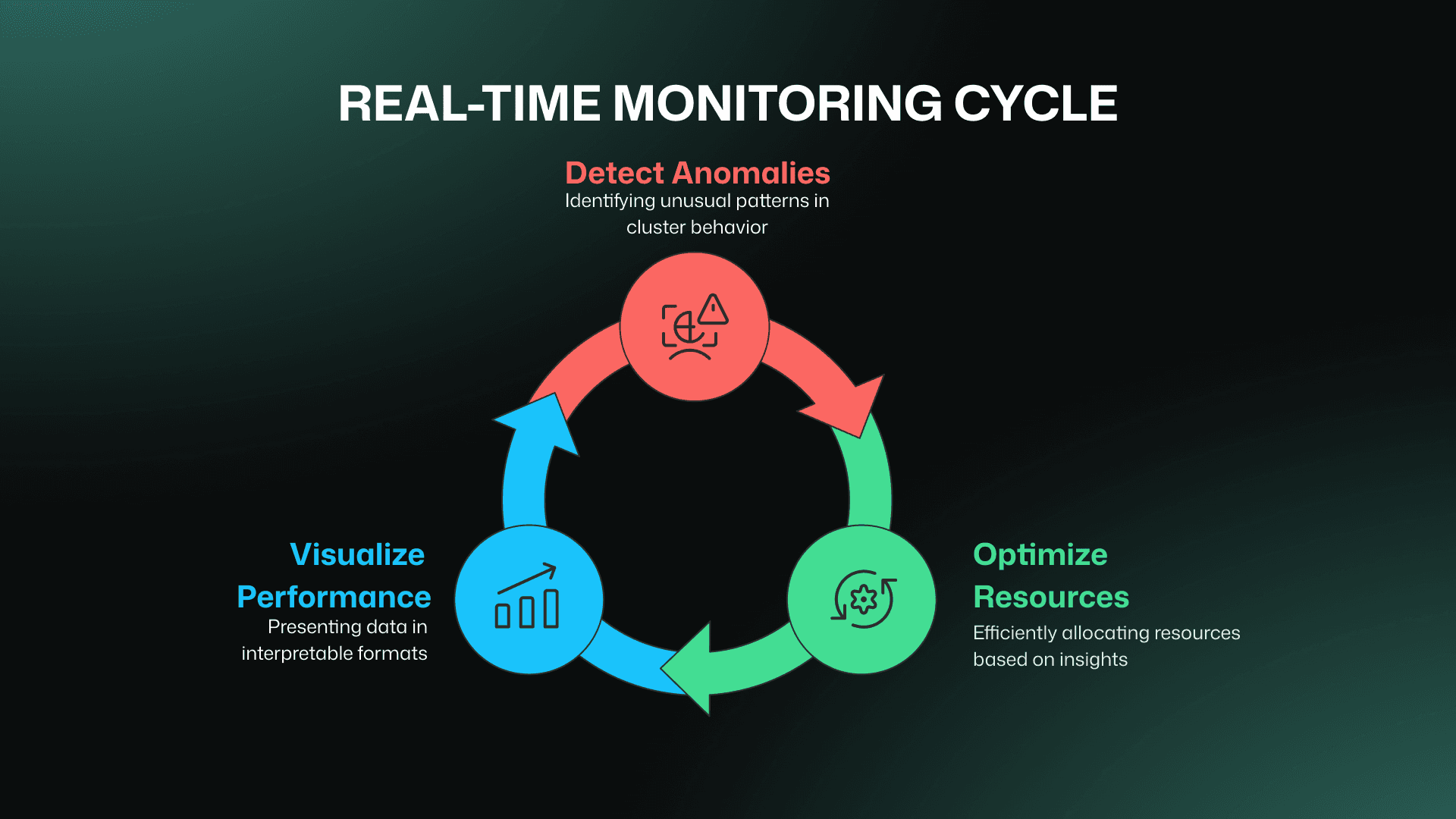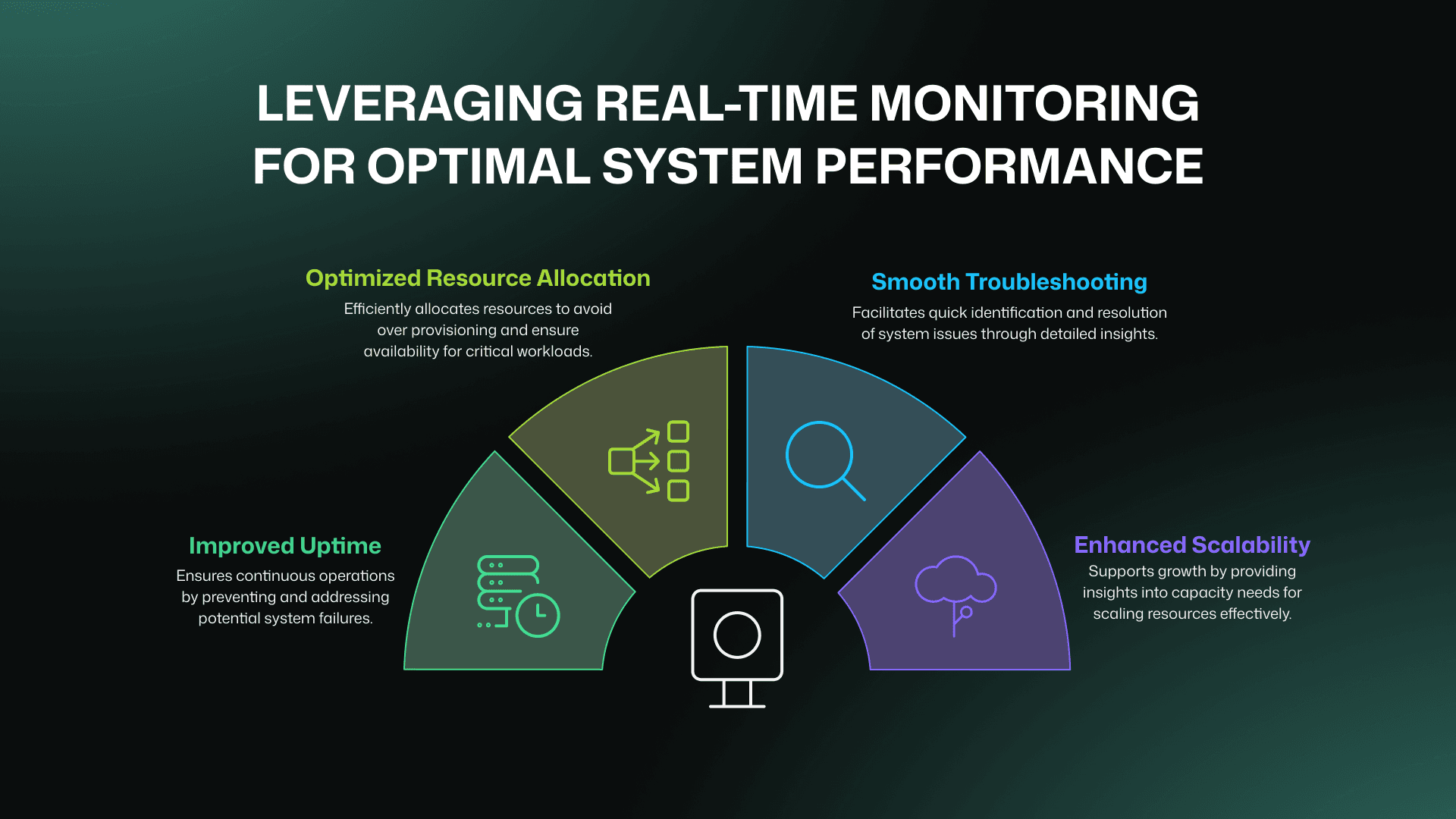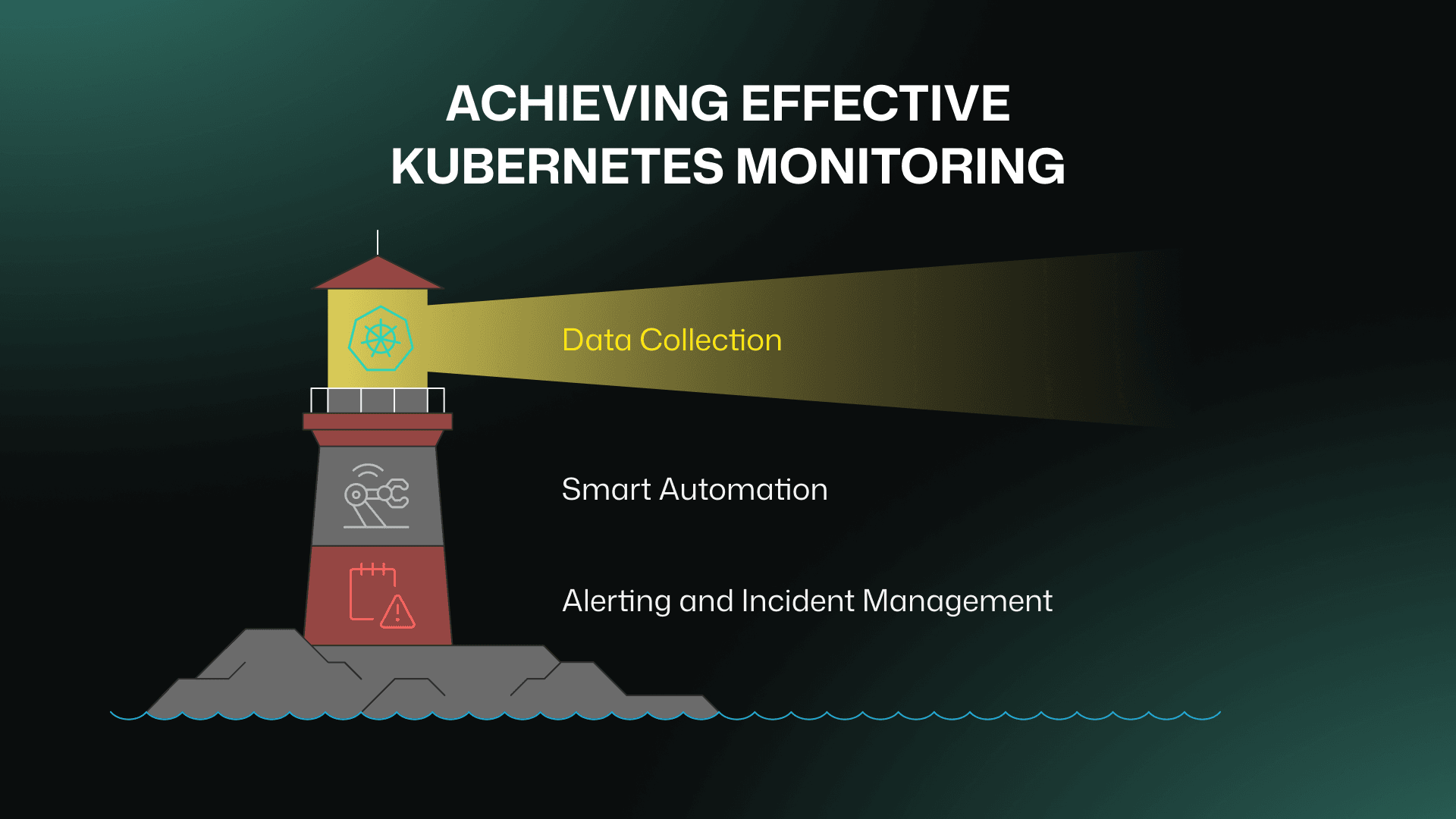Real-Time Monitoring for Kubernetes: Ensuring Uptime

Real-time Kubernetes uptime monitoring is essential for detecting potential issues before they impact end-users. By leveraging smart monitoring techniques, organizations can monitor Kubernetes performance effectively, ensuring uptime and optimizing resource allocation.
1. Understanding Real-Time Kubernetes Monitoring
Real-time monitoring is the constant tracking of your Kubernetes clusters to watch system performance, resource utilization, and application health.

Key Features of Real-Time Monitoring
- Instantly detect anomalies
Real-time monitoring identifies unusual cluster behavior patterns, such as sudden spikes in CPU usage or unexpected pod restarts, signaling potential problems.
- Optimize resource allocation
This approach also provides organizations insights into resource consumption across the cluster, enabling efficient resource allocation and cost optimization.
Traditional monitoring often relies on static thresholds, which can miss evolving issues in dynamic Kubernetes environments. Real-time monitoring adapts to these complexities, for instance, during a high-traffic event, real-time insights can help ensure uptime Kubernetes by reallocating resources swiftly to handle the load.
- Visualize performance
Real-time monitoring also collects crucial metrics such as CPU, memory, and network usage, and combines them into visual formats, making it easier for engineers to interpret data and spot performance trends over time.
2. Benefits of Real-Time Monitoring for Kubernetes Performance

Improved Uptime
Real-time monitoring tools help prevent downtime by proactively addressing potential failures. For example, detecting and resolving memory leaks in a pod can avert node crashes.
Alerts ensure that teams are notified immediately, reducing the time it takes to address critical issues and maintain smooth operations.
Optimized Resource Allocation
Monitoring tools analyze resource usage patterns, enabling teams to right-size their clusters and avoid overprovisioning. This not only reduces costs but also prevents resource starvation for critical workloads.
Smooth Troubleshooting
Real-time data provides granular insights into system behavior, allowing engineers to pinpoint the root cause of issues. For instance, identifying a spike in disk I/O might explain slow database queries.
By having access to historical trends alongside real-time data, teams can recognize recurring issues and address underlying causes more effectively.
Enhanced Scalability:
Real-time monitoring supports seamless scalability by providing a clear picture of current capacity and future needs. Teams can confidently scale resources up or down without risking overloading systems.
3. How Real-Time Monitoring Works in Kubernetes

Data Collection
Kubernetes’ native tools, such as kube-state-metrics and cAdvisor, continuously gather data on pod and node performance. These metrics cover everything from resource usage to application-specific data.
Logs and events provide additional context, such as error messages or warnings, that help correlate issues with specific events in the cluster.
Smart Automation Tools
Tools like Prometheus and Grafana work together to create real-time Kubernetes monitoring dashboards. Prometheus collects and stores time-series data, while Grafana visualizes it in intuitive formats.
Automation ensures repetitive tasks like alert configuration, incident escalation, and reporting are handled efficiently, freeing up team bandwidth.
Alerting and Incident Management
Customizable alert thresholds help prioritize critical issues without overwhelming teams with minor notifications. For instance, alerts can be set to trigger only if CPU usage exceeds 90% for over a minute.
Incident management tools integrate with monitoring systems to create tickets, assign tasks, and track resolutions, ensuring a smooth workflow during outages.
4. Best Practices for Monitoring Kubernetes in Real-Time
Start with the Right Tools
Choose tools designed for Kubernetes environments, such as Prometheus for metric collection and Datadog for holistic monitoring. These tools provide deeper insights tailored to Kubernetes workloads.
Ensure that your chosen tools can integrate with other platforms like CI/CD pipelines or cloud providers for a unified monitoring experience.
Define Key Metrics
Identify metrics that matter most to your applications, such as pod restart counts, node memory usage, and API response times. This ensures your monitoring focuses on the health of critical systems.
Leverage Automation
Implement automation to detect patterns and predict failures. AI-driven solutions can analyze historical data to anticipate problems before they occur, improving response times.
Automation also reduces manual effort, enabling teams to focus on higher-priority tasks.
Implement a Robust Alerting Strategy
Use a tiered alerting system to prioritize responses. Critical alerts should trigger immediate action, while less urgent notifications can be logged for review.
For example, a critical alert for a failed node might require on-call intervention, whereas a warning about high memory usage could be monitored over time.
Regularly Test and Optimize
Continuously test your monitoring setup to ensure it captures all relevant data and alerts are configured correctly. This reduces blind spots and improves reliability.
Optimization might involve adjusting thresholds, refining alert rules, or adding new metrics based on evolving needs.
5. Real-World Applications of Kubernetes Monitoring
- E-commerce Platform Reliability
An online retailer uses real-time Kubernetes monitoring to manage sudden traffic spikes during sales events. For instance, during a flash sale, the system detected high CPU usage in specific pods and automatically scaled up resources to handle the load.
This proactive approach ensured uninterrupted service and maintained customer trust during a critical revenue period.
- Scalable SaaS Deployment
One SaaS company leverages smart monitoring to optimize Kubernetes performance as new clients are onboarded. By analyzing real-time metrics, they identified inefficiencies in resource allocation and implemented auto-scaling policies.
As a result, the company improved client satisfaction while reducing operational costs by 20%.
6. How Bubobot Can Elevate Your Kubernetes Monitoring
Real-Time & Free Uptime Monitoring
Bubobot's tools provide constant visibility into Kubernetes clusters, ensuring API health and application uptime at all times. This level of uptime website monitoring minimizes downtime and enhances reliability.
Smart Alerts
With intelligent escalation policies, Bubobot ensures that critical issues are resolved by the right team members without delay. Alerts can be customized based on urgency and impact.
Shortest Intervals
Real-time Kubernetes monitoring with checks every 20 seconds ensures immediate detection of anomalies. This rapid feedback loop is vital for high-demand applications.
Scalable Options
Flexible pricing plans make Bubobot’s services accessible to businesses of all sizes, from startups to enterprises. As your infrastructure grows, Bubobot scales with you.
7. The Future of Kubernetes Monitoring
Predictive Analytics
Imagine knowing about a problem before it happens. AI-driven tools are making this a reality by spotting patterns in data that hint at future failures. This gives teams the chance to fix issues before they cause downtime, keeping everything running smoothly.
Deeper Integrations
Monitoring tools are becoming better at working with DevOps pipelines. This means smoother deployments and quicker feedback for your team. For example, if performance metrics drop during deployment, these tools can pause the process automatically, preventing bigger issues.
Self-Healing Systems
The future is all about systems that fix themselves. With self-healing technology, small problems can be resolved automatically, freeing up IT teams to focus on bigger priorities and ensuring your applications are always online.
Conclusion
Real-time Kubernetes monitoring is no longer optional in today’s fast-paced IT landscape. By leveraging advanced tools and practices, businesses can ensure uptime, optimize performance, and scale efficiently. The combination of automation, predictive insights, and proactive management enables organizations to stay competitive and resilient.
Let Bubobot Make Monitoring Worry-Free for Your Business.